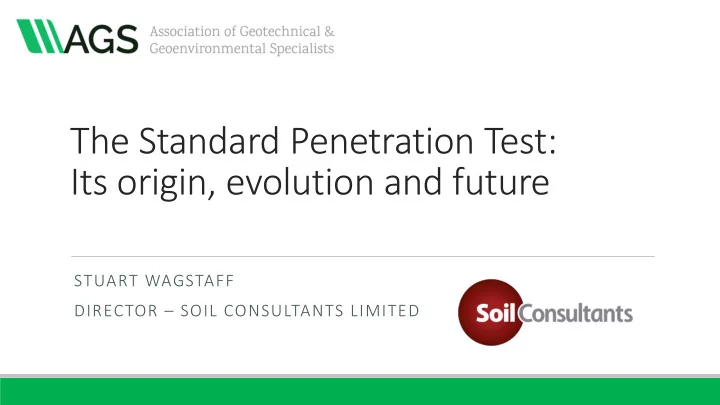

The Standard Penetration Test: Its origin, evolution and future STUART WAGSTAFF DIRECTOR – SOIL CONSULTANTS LIMITED
The Standard Penetration Test: Its origin, evolution and future Since the start of its use as a design tool back in the 1940’s, where does this leave us in 2020 and beyond? 1. a highly sensitive tool from which we obtain highly accurate soil parameters we then use to plug into highly sophisticated software to produce highly accurate predictions or ……. 2. just something we routinely do because that is what we have always done as long as the investigation is cheap and we have reliance on the poor old SI contractors PI policy? The issue we have is that it is considered a rapid, inexpensive, qualitative tool and can provide data when other sampling / testing techniques are not viable or cannot be justified financially
The Standard Penetration Test: Its origin, evolution and future Results are variable depending on things like borehole diameter, water level and depth (not to mention the drillers!) Seems to be an appreciation that there is better reliability in clay But in reality does anyone ‘standardise’ these results before design? Skempton (1986) sought to introduce the N 60 to iron out differences in the energy efficiency Surprise!!!! - ‘re-introduced’ with the Eurocodes
The Standard Penetration Test: Its origin, evolution and future Can we use the SPT as a reliable tool? Terzaghi + Peck (1947/1948/1967) – had a database to determine allowable bearing pressure Stroud (1974) – SPTs in Insensitive clays Stroud & Butler (1975) – correlation between N and Cu Simpson et al (1979) – ratio of undrained Young’s Modulus to undrained shear strength (CIRIA 153) Jardine et al (1984) – tests on London Clay matching well to the Simpson Model (CIRIA 153) Clayton (1995) – can appropriate correlations be made and is the data set large enough. Warns of sensitivity and an N value design approach not being appropriate (CIRIA 153)
The Standard Penetration Test: Its origin, evolution and future So how reliable is the SPT today? SPT calibration: Year 2012 2013 2013 2014 2015 2016 2017 2018 2019 Hammer Re-test Test house A A Er % 65 64 70 54 Test house B B Er % 69 66 59 Test house C C Er % 75 65 59 70 72 47 56 Test house D D Er % 66 65 66 70 72 77 75 74 Test house E E Er % 70 70 68 73 66 75 73 79
The Standard Penetration Test: Its origin, evolution and future Looked at London Clay and compared Cu derived from: UT100’s, Steel and Plastic U100’s, Rotary Core, Pressure Meter and SPT’s; both uncorrected and corrected for N 60
The Standard Penetration Test: Its origin, evolution and future Rotary Cored U100 Sample sample [Thick Wall Steel Tube]
Undrained cohesion kPa 0 50 10 0 15 0 20 0 25 0 30 0 35 0 40 0 45 0 50 0 0 The Standard Penetration Test: Its origin, evolution and future 5 10 15 m BGL 20 25 30 35 Self Boring Pressure Meter Cu Metal U100 Cu ROTARY Core Cu Plastic U100 SPT [ uncorrected] 1 SPT [ uncorrected] 2 SPT [ uncorrected] 3 SPT N60 [ corrected] Average
The Standard Penetration Test: Its origin, evolution and future
The Standard Penetration Test: Its origin, evolution and future UT100 to 15m Thick Wall Steel U100 below Plastic U100
The Standard Penetration Test: Its origin, evolution and future Plastic U100
The Standard Penetration Test: Its origin, evolution and future Do the results show some form of rudimentary uniformity to justify the use of SPT? Is the SPT any worse than other techniques? Would an increased data set provide a more reliable average? If we truly standardised the SPT, would we have the reliability in what was measured? Should we do more work to ‘standardise’ the technique and correlate this against back analysis to provide a more up to date correlation? Should we continue as we are? [not much has changed in the last 10 years!]
The Standard Penetration Test: Its origin, evolution and future WHERE DO WE GO FROM HERE?
The Standard Penetration Test: Its origin, evolution and future References: SKEMPTON A.W (1986) Standard Penetration Test procedures and the effects in sand of overburden pressure, relative density, particle size, ageing and over consolidation, Geotechnique 36, 3, 425-47 TERZAGHI K (1947) Recent trends in sub-soil exploration. Proc 7 th Texas Conf. Soil Mechanics and Foundation Engineering, 1-15 TERZAGHI K & PECK R.B (1948) Soil Mechanics in Engineering Practice, John Wiley, New York 1 st Edition TERZAGHI K & PECK R.B (1967) Soil Mechanics in Engineering Practice, John Wiley, New York 2 nd Edition STROUD M.A (1974) The standard penetration test in insensetive clay and soft rocks, Proc. Eur. Symp. on penetration testing (ESOPT I) 367- 75 STROUD M.A & BUTLER F.G (1975) The Standard Penetration test and the engineering properties of glacial materials. Proc Symp. On engineering properties of glacial materials, Midlands Geotechnical Society, Birmingham 117-128 CLAYTON C (1995) CIRIA 143 The standard penetration test (SPT): Methods and Use
Recommend
More recommend